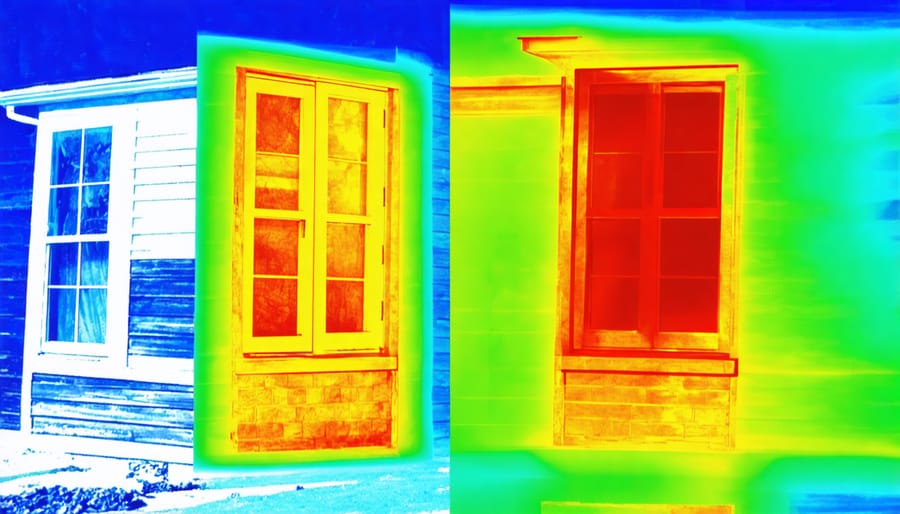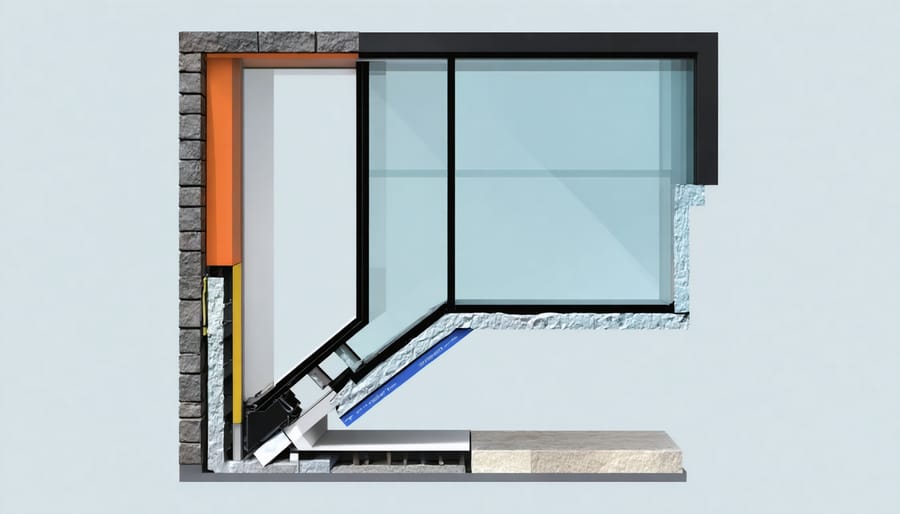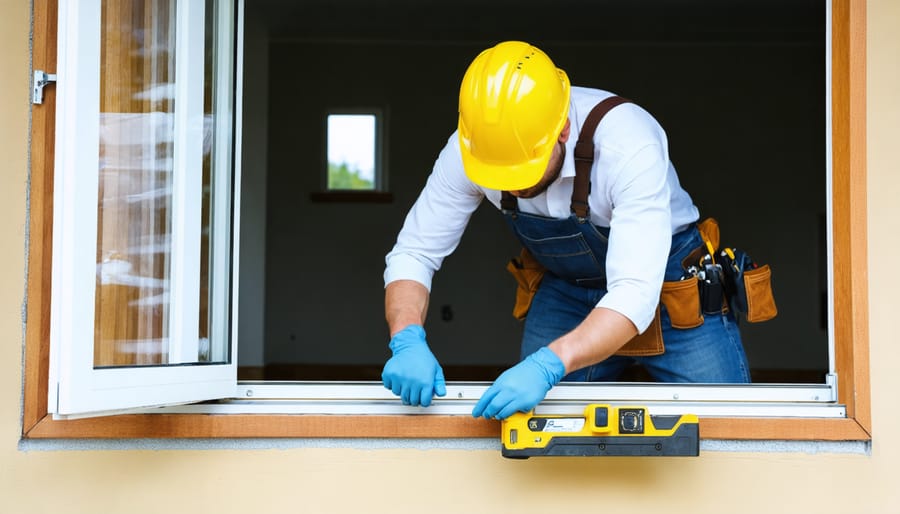Transform your home’s energy efficiency by installing double-pane windows with low-E coatings, capable of reducing energy loss by up to 50% and helping to slash your cooling costs. Measure each window opening twice, accounting for both rough and finished dimensions, to ensure a precise fit that prevents air leakage. Select ENERGY STAR certified windows with appropriate climate ratings for your region, maximizing seasonal performance and potential tax incentives. Create an airtight seal using expanding foam insulation and high-quality weatherstripping around each frame, eliminating drafts and moisture penetration.
Professional installation delivers optimal energy savings, but careful DIY installation following manufacturer specifications can achieve similar results. Modern energy-efficient windows combine advanced technologies like argon gas filling and warm-edge spacers with traditional craftsmanship, delivering superior insulation while enhancing your home’s comfort and value. The initial investment typically pays for itself within 5-7 years through reduced heating and cooling costs, making energy-efficient window installation one of the most impactful home improvements for long-term savings.
Signs Your Windows Are Costing You Money
Common Energy Loss Indicators
Is your window trying to tell you something? Several common signs indicate your windows are losing energy. Watch out for condensation or frost between glass panes, which suggests a broken seal. Cold spots near windows, visible gaps in the frame, or curtains that move on still days are clear red flags. You might also notice peeling paint, warped frames, or difficulty operating the window – all potential energy loss culprits.
Touch your windows on a cold day; if they feel notably chilly, you’re likely losing heat. Listen for whistling sounds around the frames when it’s windy, and pay attention to unexpectedly high energy bills, especially during extreme weather. Drafts are another obvious indicator – hold a lit candle near the window frame on a windy day, and if the flame flickers, you’ve got air leakage.
These signs don’t just affect your comfort; they’re literally letting your money slip through the cracks.

Understanding Window Energy Ratings
When shopping for energy-efficient windows, you’ll encounter various ratings and labels that help you make informed decisions. The most important is the ENERGY STAR® label, which indicates that a window meets strict energy efficiency guidelines set by the U.S. Department of Energy.
Key ratings to look for include U-factor, which measures how well a window prevents heat from escaping (lower numbers are better), and Solar Heat Gain Coefficient (SHGC), which shows how effectively it blocks heat from sunlight. For most climates, aim for a U-factor of 0.30 or less.
You’ll also see ratings for Visible Transmittance (VT), which indicates how much natural light passes through, and Air Leakage (AL), measuring how much air can enter through the window. The National Fenestration Rating Council (NFRC) label displays all these metrics, making it easier to compare different windows and choose the best option for your climate zone and specific needs.
Choosing the Right Energy-Efficient Windows
Frame Materials and Their Benefits
When it comes to energy-efficient windows, the frame material plays a crucial role in both performance and aesthetics. While you might be familiar with affordable window treatments, choosing the right frame material is equally important for maximum energy savings.
Vinyl frames are a popular choice among homeowners due to their excellent insulation properties and minimal maintenance requirements. They’re resistant to moisture and won’t rot or warp, making them perfect for any climate. Plus, they’re typically more budget-friendly than other options.
Fiberglass frames offer superior strength and durability while providing excellent thermal performance. They can be painted to match your home’s aesthetics and maintain their shape regardless of temperature fluctuations. Though slightly more expensive than vinyl, their longevity often justifies the investment.
Wood frames bring classic beauty and natural insulation to your home. They’re highly customizable and provide good thermal performance when properly maintained. However, they require regular upkeep to prevent moisture damage and warping.
Aluminum frames, while lightweight and durable, aren’t the best choice for energy efficiency on their own. However, when combined with thermal breaks (insulating plastic strips), they can perform quite well in moderate climates while offering a sleek, modern appearance.
Composite frames, made from a blend of materials like wood fibers and plastic polymers, offer the best of both worlds – the appearance of wood with the durability of modern materials. They’re excellent insulators and require minimal maintenance.

Glass Options and Technologies
When it comes to energy-efficient windows, the glass you choose plays a crucial role in your home’s comfort and energy savings. Let’s explore the most effective glass options and technologies available today.
Double-pane and triple-pane windows are the foundation of energy efficiency. These windows feature multiple layers of glass with sealed air or gas between them, creating excellent insulation. While double-pane windows are common and effective, triple-pane windows offer superior insulation for extreme climates.
Low-emissivity (Low-E) coating is a game-changing technology that’s virtually invisible to the eye. This microscopic layer reflects heat while allowing natural light to pass through, keeping your home cooler in summer and warmer in winter. Different types of Low-E coatings are available for various climates, so you can choose the one that best suits your region.
Gas fills between panes significantly boost insulation performance. While air is good, inert gases like argon and krypton are better insulators. Argon is the most common choice, offering excellent insulation at a reasonable price point, while krypton provides superior performance but at a higher cost.
Smart glass technologies are emerging as innovative solutions. These include electrochromic glass that changes transparency with the flip of a switch and thermochromic glass that responds automatically to temperature changes. While these options are pricier, they offer unprecedented control over your home’s environment.
The spacers between glass panes also matter. Warm-edge spacers, made from materials like structural foam, reduce heat transfer around the window’s edges, preventing condensation and improving overall efficiency.
For optimal results, consider combining multiple technologies. For instance, triple-pane windows with Low-E coating and argon gas fill provide exceptional energy efficiency. Remember to match these features with your climate and budget needs for the best return on investment.
Professional Installation vs. DIY
When to Call the Pros
While DIY window installation can be rewarding, certain situations call for professional expertise. If you’re dealing with custom-sized or specialty windows, unusual frame materials, or complex architectural features, it’s best to leave the job to experienced installers. Professional installation is also crucial for homes built before 1978, as they may contain lead-based paint that requires special handling.
Consider calling the pros if you notice structural issues around your window frames, such as rotting wood, water damage, or uneven surfaces. These problems need proper assessment and repair before installation can begin. Multi-story homes present additional safety challenges, and installing windows above ground level is best left to professionals with proper equipment and safety training.
Energy-efficient windows often come with specific warranty requirements that may necessitate professional installation to remain valid. If you’re installing multiple windows simultaneously or integrating smart home features, professional coordination can ensure everything works seamlessly together.
Signs that you should definitely contact a professional include:
– Windows larger than 40 inches in any dimension
– Building code compliance requirements
– Historic home preservation concerns
– Need for structural modifications
– Complex weatherproofing requirements
– Installation in challenging weather conditions
Remember, proper installation is crucial for maximizing energy efficiency. When in doubt, investing in professional installation can save you money and headaches in the long run.

DIY Installation Tips
Before starting your DIY window installation, carefully measure your window opening twice and gather all necessary tools, including a level, drill, caulk gun, shims, and safety equipment. Begin by removing the old window, being careful to preserve the surrounding trim if you plan to reuse it.
Clean the opening thoroughly and check for any damage or rot in the frame. Apply a continuous bead of weatherproof caulk around the perimeter of the opening. With help from another person, lift the new window into place and center it in the opening. Use your level to ensure the window is perfectly straight both vertically and horizontally.
Insert shims at the corners and midpoints to keep the window level and secure. Don’t over-tighten, as this can warp the frame. Check that the window operates smoothly before proceeding with final installation. Install mounting screws through the frame into the rough opening, following the manufacturer’s specifications for screw placement.
Add insulation between the frame and rough opening, being careful not to overfill as this can cause bowing. Apply caulk around the exterior edges to create a weathertight seal. Finally, install or reinstall the trim, and test the window’s operation one more time.
Remember, while DIY installation can save money, don’t hesitate to call a professional if you encounter any structural issues or feel uncertain about any step in the process.
Maximizing Your Window Investment
Seasonal Maintenance Tips
Keeping your energy-efficient windows in top shape requires regular maintenance throughout the year. In spring, start by inspecting the weatherstripping and seals for any winter damage. Gently clean the tracks and moving parts, removing debris that could affect smooth operation. Apply a silicone-based lubricant to keep window mechanisms working smoothly.
During summer, wash your windows inside and out with a gentle, non-abrasive cleaner and soft cloth. Pay special attention to the drainage holes at the bottom of the frames – these should be clear to prevent water accumulation. Check the caulking around the frames and reapply if you notice any gaps or cracks.
Fall maintenance is crucial for winter preparation. Test all window locks and handles to ensure proper operation. Look for drafts by holding a lit candle near the window edges (on a windless day) – flickering flames indicate air leaks that need addressing. Clean and inspect screens before storage.
In winter, prevent condensation by maintaining proper indoor humidity levels (30-50%). Remove any ice buildup carefully to avoid damaging the frames or glass. Keep an eye out for frost formation between panes in double-glazed windows, as this could indicate seal failure.
For all seasons, remember to:
– Check weatherstripping monthly
– Clean tracks and weep holes quarterly
– Inspect hardware and moving parts every six months
– Document any issues for professional assessment
– Address problems promptly to maintain energy efficiency
Complementary Energy-Saving Treatments
After installing energy-efficient windows, you can further maximize your home’s thermal performance with complementary window treatments. These additional layers not only enhance energy savings but also add style to your living spaces. Consider installing energy-efficient window treatments like cellular shades, which create air pockets that provide extra insulation.
Heavy drapes with thermal lining are particularly effective during winter months, creating a barrier against cold drafts while adding a cozy touch to your rooms. For summer cooling, reflective blinds or solar shades can block harmful UV rays and reduce heat gain. These sustainable window treatments work seamlessly with your new windows to maintain comfortable indoor temperatures year-round.
Don’t overlook external options like awnings or solar screens, which can reduce solar heat gain by up to 65% on south-facing windows and 77% on west-facing windows. Window films offer another layer of protection, blocking UV rays while maintaining visibility. For a natural approach, strategically planted deciduous trees provide shade during summer while allowing beneficial solar heat gain during winter when leaves fall.
Remember to adjust your window treatments seasonally: open them during sunny winter days to capture free solar heat, and close them during peak summer hours to keep your home cooler naturally.
Installing energy-efficient windows is a smart investment that pays dividends in both comfort and cost savings. Throughout this guide, we’ve explored the essential aspects of selecting and installing these modern window solutions. Remember that proper installation is just as crucial as choosing the right windows – even the most energy-efficient products won’t perform optimally if they’re not installed correctly.
By following the steps we’ve outlined, you can ensure your new windows will provide maximum energy savings, enhanced comfort, and improved home value. Whether you’re tackling this as a DIY project or working with professionals, understanding the process helps you make informed decisions and achieve the best results.
Don’t forget to maintain your new windows regularly and check for any signs of wear or damage that might compromise their efficiency. Small issues caught early can prevent larger problems down the road and help maintain your windows’ energy-saving properties for years to come.
Consider starting with a few windows if you’re working on a budget, focusing on areas where you notice the most heat loss or discomfort. As you see the benefits in your energy bills and home comfort, you can plan to upgrade remaining windows over time.
Ready to start your energy-efficient window project? Take the first step by assessing your current windows and planning your upgrade strategy. With proper research, preparation, and installation, you’ll be well on your way to a more comfortable, energy-efficient home that saves money while helping the environment.
